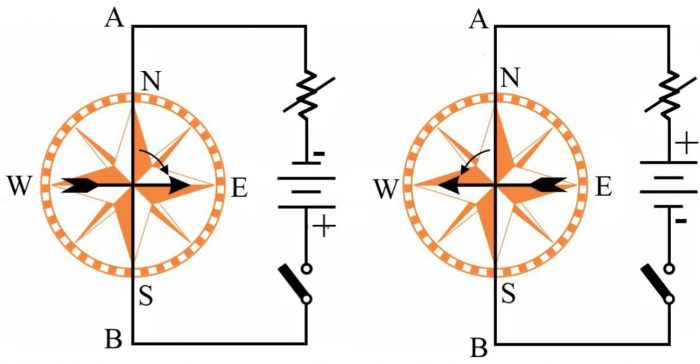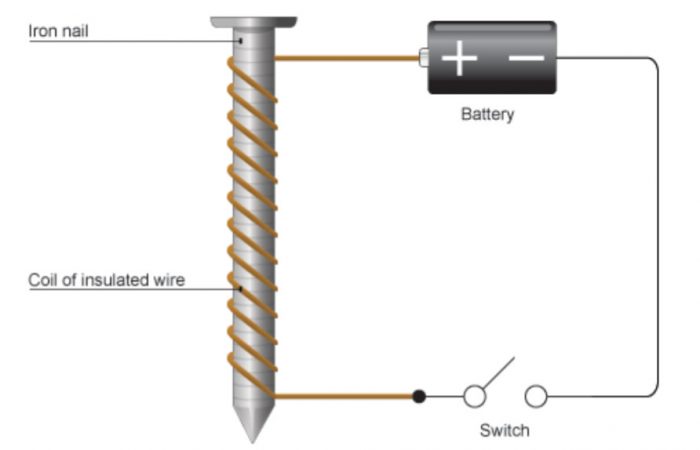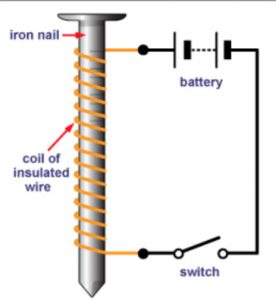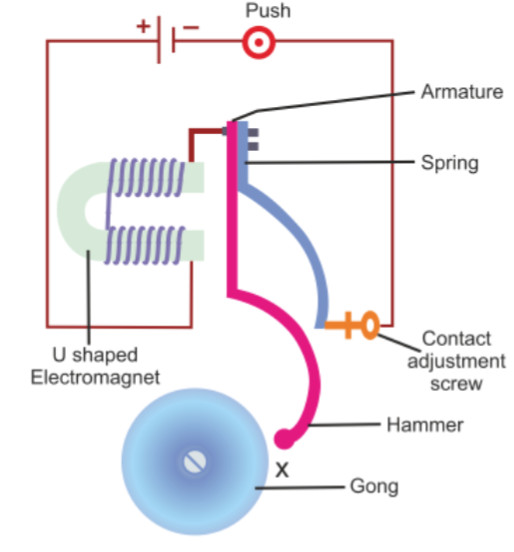Question 1 What is an electromagnet? How can we make an electromagnet?
Question 2 Mention two advantages of electromagnet over a permanent magnet?
Question 3 Describe the construction and working of electromagnet?
Question 4 What is meant by magnetic effect of current?
Question 5 Why do we use iron for making an electromagnet and not steel?
Question 6 State few uses of electromagnet?
Contents
Magnetic effect of Electric Current
When electric current passes through a wire, the current-carrying wire behaves like a magnet. This is called the magnetic effect of current. The magnetic effect of current is utilised in making electromagnets, electric bells, telephone instruments, electric fans, electric motors, loudspeakers and toys etc.
The magnetic effect of current was discovered by a scientist named Hans Christian Oersted. Oersted found that when electric current was passed in a wire, then the needle of deflected from its usual north-south position. Now, the needle of a compass is itself a tiny magnet (which can rotate freely on a pivot). A compass needle can be deflected only by another magnet’s magnetic field.
Since a current-carrying wire was able to deflect a compass needle, it was concluded that the electric current flowing in a wire gives rise to a magnetic field around it. It is this magnetic field produced by the current-carrying wire which exerts a force on the compass needle and deflects it (or moves it).
Activity: To demonstrate the magnetic effect of current
(1) We take a thick, insulated copper wire AB and fix it on a table in such a way that this wire is in the north-south direction.
(2) A compass is placed under the wire AB. The two ends of the wire AB are connected to a cell through a switch by using connecting wires.
(3)The switch is open, so no current is flowing in the wire AB. When no current is flowing in the wire AB, then the needle of compass is parallel to the wire AB and points in its usual north south direction
(4) Now close the switch so that an electric current passes through the wire AB.We will find that when current is passing through the wire AB, then the needle of compass is deflected from its original north-south direction and points in another direction.
(5) A compass needle is deflected only when it is acted upon by another magnet (or magnetic field). So, the deflection of compass needle here shows that the current-carrying wire placed above it is behaving like a magnet and producing a magnetic field around it.
(6) It is the magnetism produced by current-carrying wire which is exerting a force on the compass needle and deflecting it from its usual north-south position.
(7) If we now open the switch so that the current stops flowing in the wire AB, we will find that the compass needle comes back to its original position. This shows that when electric current flowing in a wire stops, then the magnetism produced by it disappears.
The magnetic effect is increased if we use a long coil of wire (instead of a straight wire). The magnetic effect is even further increased if the coil of wire is wound around an iron rod and then current is passed through it.
Electromagnets
The magnet made by using electric current is called an electromagnet. An electromagnet works on the magnetic effect of current.
An electromagnet consists of a long coil of insulated copper wire wound around an iron rod. When the two ends of the coil are connected to a cell, a current passes through the coil and produces a magnetic effect. This magnetic effect magnetises the iron rod. So, the iron rod becomes an electromagnet.
The magnetism of an electromagnet remains as long as the current is flowing in its coil. If we switch off the current in the coil (by opening the switch), all the magnetism of the iron rod disappears and it no longer behaves as a magnet.
An electromagnet is a magnet consisting of a coil of insulated wire wrapped around a piece of iron that is magnetised only when electric current is passed through the coil.
Only iron is used for making electromagnets. This is because when current is switched off in the coil of an electromagnet made of iron piece, then the iron piece loses all its magnetism.
Steel is not used for making electromagnets because when current is switched off from the coil of an electromagnet made of a steel piece, the steel piece does not lose all its magnetism. The steel piece retains the magnetism and becomes a permanent magnet.
An electromagnet can attract and hold only the objects made of magnetic materials such as iron, steel, nickel and cobalt. An electromagnet cannot attract objects made of non-magnetic materials such as wood, plastic, paper, copper and aluminium, etc
Activity : To make an electromagnet
(1) Take a long insulated copper wire (The insulated copper wire should be quite thin).
(2) Also take a large iron nail.
(3) Wind the insulated copper wire round and round closely on the iron nail so that it may form a coil.
(4) Connect the free ends of the coil of wire to the two terminals of an electric cell through a switch.
(5) Switch on the current in the coiled wire by closing the gap in the switch. Now, place some steel pins near one of the ends of iron nail. We will find that the steel pins cling to the iron nail.
(6) The iron nail attracts the steel pins because the electric current flowing in copper wire coil (wrapped around it) has turned the iron nail into an electromagnet.
Switch off the current through the coiled wire by opening the gap in the switch. We will find that on switching off current through the coil, the steel pins get detached from the iron nail, they no longer cling to the iron nail. When current is stopped from flowing in the coil of wire, the iron nail no longer remains a magnet. Since the iron nail loses its magnetism, therefore, the steel pins do not cling to it anymore.
Thus, the iron nail behaves as a magnet only when electric current flows through the coil of insulated wire wrapped around it. When the electric current flowing in the coil is stopped, the iron nail loses its magnetism.
Advantages of Electromagnets over Permanent Magnets
An electromagnet is a temporary magnet because its magnetism is only for the duration of current flowing in its coil.
Advantages of the electromagnets
(1) The magnetism of an electromagnet can be switched on or switched off as desired. This is not possible with a permanent magnet.
(2) An electromagnet can be made very strong
(a) by increasing the number of turns in the coil
(b) by increasing the current passing through the coil.
Uses of Electromagnets
(1) Electromagnets are used in the construction of a large number of devices like electric bells, loudspeakers, electric motors, electric fans, toys and telephone instruments, etc.
(2) Electromagnets are used to lift heavy loads like big machines, steel girders and scrap iron objects for loading and unloading purposes. The electromagnets which are used for loading and unloading heavy iron and steel objects are fitted on cranes.
(3) Electromagnets are used to separate magnetic materials like iron and steel objects from a heap of metal scrap (or junk).
(4) Electromagnets are used by doctors to remove tiny iron particles from the eyes of a person.
Electromagnets are made in different shapes and sizes depending upon the purpose for which they are to be used.
For example : An electric bell uses a U-shaped electromagnet for its working. The U-shaped electromagnet is made by using U-shaped iron piece. In the U-shaped electromagnet, we have two coils of the same insulated copper wire wound on each side of the U-shaped iron piece.
Electric Bell
The electric bell works on the magnetic effect of current. It has an electromagnet in it. The electric bell uses an electromagnet to pull the clapper on to a metal bell (called gong). The clapper of electric bell is also known as hammer.
Construction of Electric Bell
(1) The electric bell has a U-shaped electromagnet.
(2) A small iron bar called armature is held in front of the poles of the electromagnet.
(3) The lower end of iron bar is attached to a flat spring and the flat spring is itself fixed to a metal bracket.
(4) The upper end of iron bar has a clapper attached to it. Initially, when the bell is not working, the clapper or hammer is at a short distance away from the gong.
(5) There is a contact screw which just touches the iron bar at point. The contact screw is also called an interrupter because it interrupts (or breaks) the circuit of electric bell periodically.
(6) A metal gong (which is hollow like a bicycle bell) is fixed near the clapper. The bell works with a battery and a push-button switch is provided to ring the bell.
(7) The end of the electromagnet coil is connected to one terminal of the battery and the other end of the coil is connected to bracket carrying the iron bar (or armature).
(8) The other terminal of battery is connected to the contact screw through the push-button switch .
Working of Electric Bell
In order to ring the bell, we press the push-button switch. When we press the switch, the electric circuit of the bell is completed and a current passes through the coil of the electromagnet and it gets magnetised. The electromagnet attracts the iron armature towards itself. As the armature moves towards the poles of the electromagnet, the clapper attached to it strikes the gong and produces a ringing sound. We say that the bell rings.
When the armature moves towards the magnet, its contact with the contact screw is broken at point . Due to this the electric circuit breaks and no current flows in the electromagnet coil. The electromagnet loses its magnetism for a moment and the armature is no longer attracted by it. The flat spring brings back the iron armature to its original position and the clapper also moves away from the gong.
As soon as the armature comes back and touches the contact screw, the circuit is completed and current starts flowing in the electromagnet coil again. The electromagnet attracts the iron armature once again and the clapper strikes the gong again producing a ringing sound.
This process of make and break of the electric circuit continues as long as we are pressing the switch. Due to this, the armature vibrates forwards and backwards rapidly each time making the clapper strike the gong. Thus, the clapper strikes the gong rapidly producing almost continuous sound. And we say that the bell is ringing.




Thanks teacher , you helped me a lot with these notes. Regards.
The clarity of presentation of the information is fabulous. The practical uses of the electromagnet listed greatly aid understanding. Thank you so much.